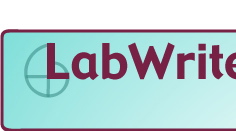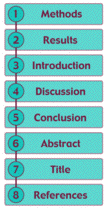SECTION THREE : Introduction
Establishing a context for the lab
Step 1: Begin the Introduction
with 1 or 2 sentences clearly stating what scientific concept the lab
is about. Then finish the paragraph by writing down details about this
concept relevant to the lab that you can find in the lab manual, textbook,
class notes, handouts, etc . . . Revise your answer so that it includes
only the information that relates specifically to this lab. If you have
a lot of information, make two paragraphs. Note any citations you use
here for including in the References section of your report.
More Help:
- If you are having trouble writing a good opening sentence for the
lab report, you can say something like: "This laboratory experiment
focuses on X…"; "This laboratory experiment is about
X…" ; "This lab is designed to help students learn about,
observe, or investigate, X…." Or begin with a definition of
the scientific concept: "X is a theory that…."
- Once you have your opening sentence, you are ready to complete the
opening paragraph by telling what you know about the scientific concept.
The point is to show your lab instructor that you have a good grasp
of the scientific concept. Revise the rest of Question 1 by:
- Focusing it so that it contains information about the concept
that is most clearly related to the lab procedure (not everything
there is to know about the concept)
- Incorporating additional relevant information about the concept
you may have learned since doing the PreLab.
- Changing it so that the scientific concept is appropriate to the
lab (this would apply if all or parts of what you wrote about the
scientific concept in the PreLab are wrong for this lab).
- If you have a lot to say about the scientific concept, use more than
one paragraph.
- This part of the Introduction is typically written in present tense.
For more advanced labs:
If you are writing a lab report that is more
like a full scientific paper, you may need to do more research using
the Internet and library. With your teacher's guidance, you should search
the recent scientific literature to find other research in this area
of study. Summarize that research in a paragraph or so, stating what
the general findings have been and using those findings to describe
the current knowledge in the area (such a "review of the literature"
is typical of scientific journal articles). This summary should come
after your initial sentence about the scientific concept. For help with
citing references, go to Citations
and References.
Step 2: Write the main objectives
of the lab--the specific actions you took in the lab, such as measure,
analyze, test--in sentence form. Then complete the paragraph by describing
how the achievement of these objectives helped you learn about the scientific
concept of the lab.
More Help:
- Objectives are typically actions you are being asked to perform for
the lab. Often the objectives are listed in the lab manual. Writing
the objectives of the lab in your own words demonstrates your understanding
of what you were supposed to accomplish in the lab. With most labs,
you should be able to do this in 1 or 2 sentences. You can begin by
saying something like: "The main objectives of this lab were to…";
"In this lab we were asked to…." This will be the beginning
of the paragraph.
- Continue the paragraph by addressing the purpose of the lab. This
is where you make the all-important link between what you do in the
lab (the objectives) and the purpose for doing the lab: to learn something
about the scientific concept of the lab. Read over the objectives again.
In what way do you think that doing the experiment, accomplishing the
objectives, helped you learn about the scientific concept? You can start
by saying something like this: "The objectives of this lab enabled
me to learn about X by…"; "Performing these objectives
helped me to understand X by…."
- This part of the Introduction is usually all in past tense.
Step 3: State your hypothesis,
what you thought the outcome of the experiment would be before you did
it. This will be the first sentence of the hypothesis paragraph. To write
a scientific hypothesis, you first need to identify the independent
and dependent variables in the experiment.
More Help:
Step 4: Continue the paragraph you began
with a hypothesis by explaining how you used your understanding of the
scientific concept of the lab to arrive at your hypothesis.
More Help:
- As you are explaining the reasoning you used to come to your hypothesis,
be sure to make a direct connection between the hypothesis and the scientific
concept of the lab. Rewrite it so that your reader can clearly see how
you used your understanding of the scientific concept of the lab to
make a prediction about the outcome of the lab. Refer to what you said
in the first paragraph of the Introduction.
- One way to make your explanation clear is to use words that show causal
links: because, since, due to the fact that,
as a result, therefore, consequently, etc.
For example, Since X happens in order to maximize energy, we hypothesized
that . . .
- If your explanation is relatively long, use more than one paragraph.
|





